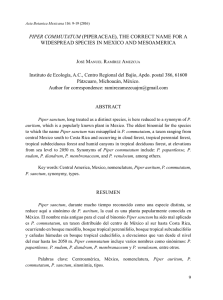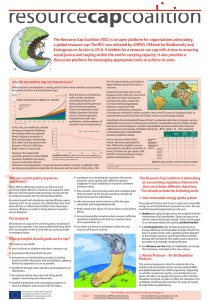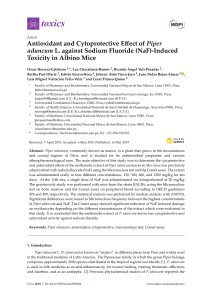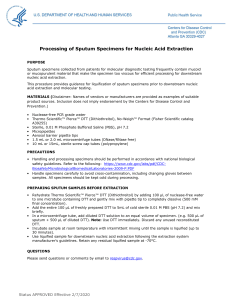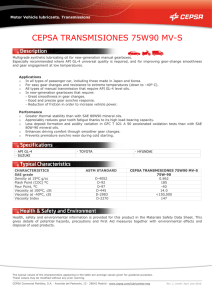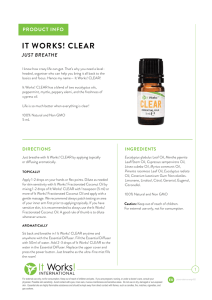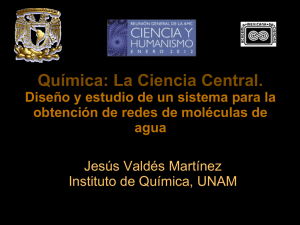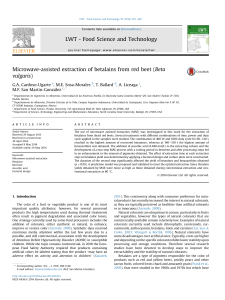EXTRACTION, CHEMICAL COMPOSITION AND ANTIMICROBIAL
Anuncio
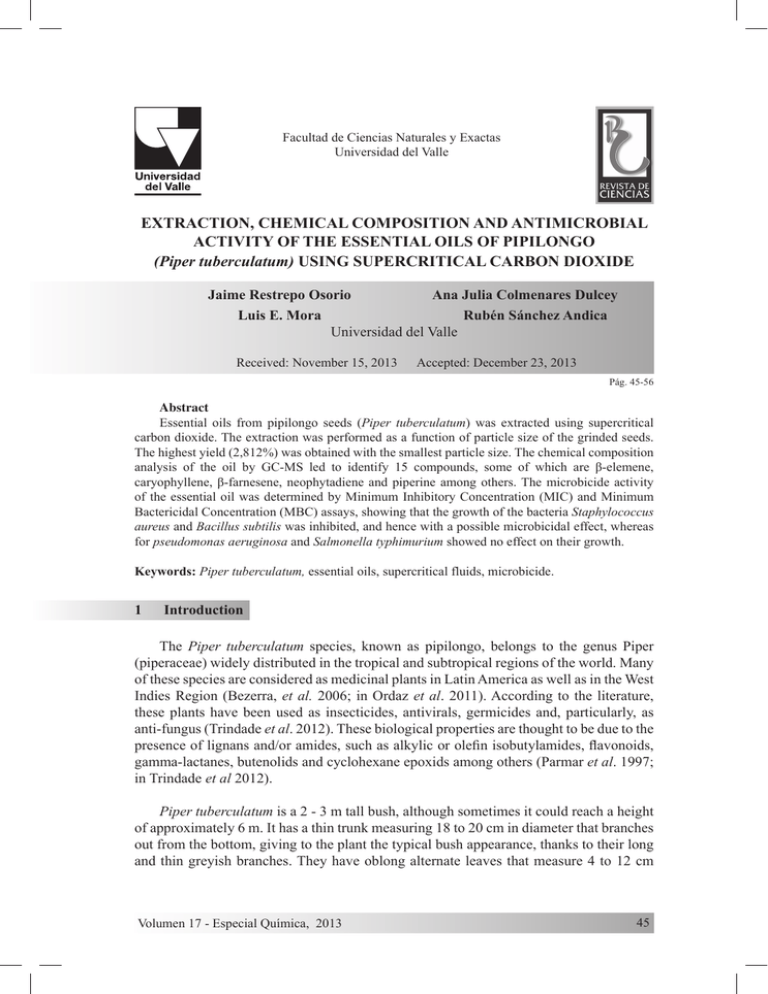
Facultad de Ciencias Naturales y Exactas Universidad del Valle EXTRACTION, CHEMICAL COMPOSITION AND ANTIMICROBIAL ACTIVITY OF THE ESSENTIAL OILS OF PIPILONGO (Piper tuberculatum) USING SUPERCRITICAL CARBON DIOXIDE Jaime Restrepo Osorio Ana Julia Colmenares Dulcey Luis E. Mora Rubén Sánchez Andica Universidad del Valle Received: November 15, 2013 Accepted: December 23, 2013 Pág. 45-56 Abstract Essential oils from pipilongo seeds (Piper tuberculatum) was extracted using supercritical carbon dioxide. The extraction was performed as a function of particle size of the grinded seeds. The highest yield (2,812%) was obtained with the smallest particle size. The chemical composition analysis of the oil by GC-MS led to identify 15 compounds, some of which are β-elemene, caryophyllene, β-farnesene, neophytadiene and piperine among others. The microbicide activity of the essential oil was determined by Minimum Inhibitory Concentration (MIC) and Minimum Bactericidal Concentration (MBC) assays, showing that the growth of the bacteria Staphylococcus aureus and Bacillus subtilis was inhibited, and hence with a possible microbicidal effect, whereas for pseudomonas aeruginosa and Salmonella typhimurium showed no effect on their growth. Keywords: Piper tuberculatum, essential oils, supercritical fluids, microbicide. 1 Introduction The Piper tuberculatum species, known as pipilongo, belongs to the genus Piper (piperaceae) widely distributed in the tropical and subtropical regions of the world. Many of these species are considered as medicinal plants in Latin America as well as in the West Indies Region (Bezerra, et al. 2006; in Ordaz et al. 2011). According to the literature, these plants have been used as insecticides, antivirals, germicides and, particularly, as anti-fungus (Trindade et al. 2012). These biological properties are thought to be due to the presence of lignans and/or amides, such as alkylic or olefin isobutylamides, flavonoids, gamma-lactanes, butenolids and cyclohexane epoxids among others (Parmar et al. 1997; in Trindade et al 2012). Piper tuberculatum is a 2 - 3 m tall bush, although sometimes it could reach a height of approximately 6 m. It has a thin trunk measuring 18 to 20 cm in diameter that branches out from the bottom, giving to the plant the typical bush appearance, thanks to their long and thin greyish branches. They have oblong alternate leaves that measure 4 to 12 cm Volumen 17 - Especial Química, 2013 45 Revista de Ciencias J. Restrepo, A. J. Colmenares, L. E. Mora and R. A. Sánchez long and 2 to 6 cm wide with pinnate veins, lobulated base which constitutes a significant characteristic since its bright green leaves have one side longer than the other and its border is slightly serrated (Gargiullo et al 2008). In Colombia, pipilongo is a very important species from the cultural and economic point of view. Abroad, it is known as an original regional Colombian Chocó plant due to its use in regional typical beverages and as a spicy flavoring for foods. Additionally, in the culture of the Eastern Colombian Plains its leaves are used as a hemostatic in venomous snake bites. Piper tuberculatum has uses that go beyond the culinary and sustainability of soils, since some natural biological active products have been isolated and its essential oils have been characterized; some bioactive properties have been assessed such as bactericide, insecticide, antimutagenic and antioxidant activity, among others (Facundo and Morais, 2005). These properties are attributed to some amides that have been isolated and identified from the seeds using a mixture of DCM-MeOH (dichloromethanemethanol). Two of these amides were found to be isobutylic amides and five of them are piperidinic (Navickiene et al. 2000). All of these amides were tested individually against Cladosporium sphaerospermum, resulting that the minimum quantity required to inhibit fungi growth was in the range of 0.1 to 5 mg. (Navickiene et al. 2000) and the amount needed against C. cladosporides, was in the range of 5 to 10 mg (Silva et al. 2002). Piperine, (C17H19NO3) is an organic compound found in Piper tuberculatum. Its odor has been described as ammoniacal and similar to that of pepper. It is widely used as a precursor in the synthesis of several organic compounds including some drugs. Additionally, piperine is one of the numerous natural alkaloids that gives to black pepper its spicy flavor and it is part of the toxins of the red ants, analogous to nicotine. Kuomoro et al. (2009) published a paper in which outlined the interest of this natural molecule for therapeutic application as resulting of some medical studies. These works have shown that this alkaloid helps to increase the absorption of vitamin B, β-carotene and selenium occasioning the rise of the generation of energy in the cell and consequently, it has been useful in the treatment of defective intestinal lining. Other application for this compound is as repellent for some insects; for instance, it has shown to be an effective insecticide against flies. Piperine, as well as other compounds in Piper tuberculatum, can be extracted by several techniques, including supercritical fluids which is an alternative technique for extraction of bioactive compounds and has lately been establishing as a better option due to the time and organic solvent reduction in extraction processes as well as for its capability in the extraction of thermolabile compounds. The aim of this work is to determine the chemical composition of essential oils extracted from pipilongo and specially, to determine the presence of piperine from a Colombian variety, using gas chromatography coupled to mass spectrometry (GC-MS), its bactericide potential, as well as, to determine the antioxidant activity by free radical (DPPH) technique. 46 Extraction, chemical composition and antimicrobial activity of piper tuberculatum 2 Materials and methods 2.1 Plant material The fruit of Piper tuberculatum (seed) used in this investigation is light green in color with a small black dots, it is 7 cm – 10 cm in length and 2 mm to 5 mm width. The seeds were collected in Buenos Aires, Departamento del Cauca, located in the Southern region of Colombia (altitude of 1200 MMSL, average temperature of 22 °C, and average annual rainfall of 202 mm). The seeds were provided by the SI Jamundí foundation and botanically identified at Herbarium of the Biology Departament at Universidad del Valle. 2.2 Preparation of plant material The seeds of pipilongo were selected under the adequate conditions for the analysis. After that, the drying process was carried out in an oven at a temperature of 50 °C during 6 to 8 hours. The dried samples were grinded using an IKA A11 grinder with the stainless blade. Afterwards, the sample was sieved mechanically using sieves 18 mesh (1mm), 60 mesh (0.250 mm) and 120 mesh (0.125 mm). The order of the retention of particles is as follows: 0/18: For particles retained in the first sieve. 18/60: For particles retained in the second sieve. 60/120: For particles retained in the third sieve. Collector: For particles in the final collector. 2.3 Extraction and analysis of the essential oils 2.3.1 Extraction using supercritical carbon dioxide The experimental conditions of the extraction of the essential oil of pipilongo were performed based on the procedure of Kuomoro et al. (2009). The supercritical fluid extraction was carried out on an equipment according with the design of Restrepo et al. (2009), schematically represented in figure 1, and available in the Laboratory of Analysis and Research on foods at Universidad del Valle. 2 g of the dried and sieved pipilongo flour were weighed and put it in the extraction cell. The extraction was made with supercritical carbon dioxide at 40 °C and 2000-2500 psi pressure. The flow rate of the extraction was 5 mLmin-1 and the total extraction time was 2 hours continuously, after that, the essential oils were received in the collector vial. The collected oil was used in further experiments. This procedure was repeated for the samples with different particles size. Volumen 17 - Especial Química, 2013 47 Revista de Ciencias J. Restrepo, A. J. Colmenares, L. E. Mora and R. A. Sánchez Figure 1. Experimental equipment for supercritical fluid extraction. 2.3.2 Analysis of essential oil by GC – MS The chemical analysis procedure of the essential oil was based on the work reported by Ordaz et al. (2010). In order to determine the chemical composition of the essential oil of Piper tuberculatum, the sample with higher yield of extraction was used. The characterization analysis was performed by Gas Chromatograph coupled with a Mass Spectrometer (CG-MS) on a Shimadzu QP2010 instrument. Chromatographic and mass spectrometric conditions are given in table 1. Table 1. GC-MS parameters. CG conditions Type of GC Injection port Analytical column Temperature program Temperature of GC-MS interface Carrier gas MS conditions Type of MS Ionization mode Ion source temp Scan mode Scan time 48 Shimadzu GC 2010 Splitless (liner 1.2 mm ID) XTI®-5 (fused silica, 5% phenyl), 30 m x 0.25mm ID, 0.25 film thickness. 70 (2 min) then at 10 °C/min up to 300 °C (20 min) 300 °C He (8mLmin-1), 99.999% ´ Quadruple mass´ detector (Shimadzu QP 2010) Electron impact (70 eV) 230 °C Full scan monitoring (from 15 m/z to 800 m/z) 45 min Extraction, chemical composition and antimicrobial activity of piper tuberculatum 20 μL to 30 μL of the essential oil was dissolved in 1 mL of chloroform HPLC grade and 1μL of diluted oil was injected in GC-MS system. 2.4 Antimicrobial activity The antimicrobial activity of the essential oil of pipilongo was performed by the Minimum Inhibitory Concentration (MIC) and Minimum Bactericidal Concentration (MBC), according to micro-dilution AOAC method. The microorganisms tested were Salmonella typhimurium (ATCC), Pseudomonas aeruginosa (ATCC), Staphylococcus aereus (ATCC) and Bacillus subtilis (ATCC). Aliquots of 0.4 mL of the oil obtained was dissolved in DMSO and transferred to a test tubes containing 3.6 mL of Trypcase Soy Broth Agar (TSBA) (Scharlau); afterwards, serial dilutions (1:1 ratio) were made by triplicate in 10 consecutive test tubes for every microorganism. Inoculum was prepared from working culture reactivated in 18 – 24 hours before the test, which were diluted with 0.1 % peptonated water and adjusted to the standard No 1 of MacFarland scale. From these tubes, decimals dilutions were made and they were inoculated containing the sample, equivalent to 5 log10 UFC/mL. All Inoculated tubes were incubated at 35 °C ± 2 °C for S.typhimurium and S. aereus, and 30 °C ± 2 °C for P. aeruginosa and B. subtilis for 24 up to 48 hours. Passed this incubating time, test tubes with visible growth (by turbidity) were observed and recorded in order to calculate the MIC. From those tubes with positive result and using the more diluted tube, harvesting on TSBA were made in order to verify the absence or presence of bacteria growth, and consequently, to calculate the MBC. In all cases, positive controls of microorganism growth were made, as well as negative controls of sterility. 2.5 Antioxidant activity The antioxidant assay of pipilongo essential oil was performed following the procedure described by D´mello et al. (2008), which consists in quantifying the scavenging ability of free radical (2,2’-Diphenyl-1-picrylhydrazyl-DPPH) by the sample (antioxidant). Several diluted solutions of the sample were added to the DPPH solutions, using isopropyl alcohol as solvent, then, the reduction in absorbance is measured in a spectrophotometer at 520 nm after 1 hour of reaction. This procedure was carried out simultaneously with quercetine and ascorbic acid as positive controls. The EC50, which represents the concentration of the sample that can cause the reduction of DPPH concentration to the half, was calculated. Volumen 17 - Especial Química, 2013 49 Revista de Ciencias 3 J. Restrepo, A. J. Colmenares, L. E. Mora and R. A. Sánchez Results and discussion 3.1 Extraction of pipilongo essential oils A Yellow-greenish, very fluid, soluble in ethanol and acetone oil was obtained. It has a strong ammonium odor (similar to that of pepper) and with a bitter and spicy flavor. Previous to the chemical analysis, an evaluation of the yield of the extraction related to the particle size was made. 3.2 Extraction of essential oils in accordance to the particle size Yield of the essential oil from milled and sieved seeds of pipilongo was evaluated. Three particle size of the flour were tested. Table 2 shows the yields achieved for every particle size. Table 2. Yield of the essential oil according to the particle size. Particle size tested 0/18 18/60 60/120 Sample weight (g) 8.7780 7.9972 8.0256 8.0200 8.2029 7.9991 7.9598 8.0178 8.0635 Essential oil (g) 0.0208 0.0797 0.0546 0.1461 0.1429 0.1226 0.2816 0.2428 0.1509 Yield of extraction (%) 0.237 0.997 0.680 1.822 1.742 1.533 3.538 3.028 1.871 Mean (%) 0.64±0.43 1.70±0.17 2.81±0.97 From table 1, it can be said that the yield of the essential oils extracted from the flour with the higher particle size (1 mm = 18 mesh) are the lowest, while the highest yield was reached with the smallest particle size (0.125 mm = 120 mesh). Under the conditions of the extraction, supercritical carbon dioxide can dissolve and extract components (essential oils in this case) of the plant better as the particle size decreases. This effect was expected considering that samples with a very small particle size has a great contact surface, and hence it increases the affectivity of the extraction. In short, it can be said that the particle size has a remarkable effect on the yield of the extraction of essential oils using supercritical carbon dioxide. 3.3 Characterization of essential oils of pipilongo by GC – MS The Total Ion Chromatogram (TIC) of the essential oils is shown in figure 2. It can be seen that there are more than 20 compounds, 15 of which could be identified by mass library. Table 3 shows the compounds found that were identified. 50 Extraction, chemical composition and antimicrobial activity of piper tuberculatum Table 3. Chemical composition of essential oils of pipilongo. Peak No. Name of compound 1 2 3 4 5 6 7 8 9 10 11 12 13 14 15 α-Copaene β-Elemene Caryophyllene β-Cubenene β-Farnesene Germacrene D Zingeberene α-Muurolene δ-Cadinene Neophytadiene Methyl Hexadecanoate Methyl linoleate di-2-ethylhexyladipate 1-(9-octadecenoyl) piperedine Piperine Retention time (min) 10.175 10.375 10.783 10.942 11.125 11.633 11.725 11.775 12.050 15.400 16.308 17.950 20.562 23.692 24.642 Molecular formula C15H24 C15H24 C15H24 C15H24 C15H24 C15H24 C15H24 C15H24 C15H24 C20H38 C17H34O2 C19H34O2 C22H42O4 C23H43NO C17H19NO3 Figure 2. TIC of the essential oil extracted from the pipilongo seed (Piper tuberculatum). Maia et al. (2007), published a serie of terpenes and other compounds in some piper species using hydrodestillation, founding monoterpenes, sesquiterpenes and oxygenated sesquiterpenes mainly. Some of these compounds are α-pinene, camphene, β-pinene, myrcene, α-copaene, β-elemene, caryophyllene, α-muurolene, germacrene D, among others. In other paper are reported that pepper oils are a mixture of sesquiterpenes (10%) and other hydrocarbons and aromatic compounds (90%) (Ferreira et al. 1999). These results are consistent with those found in this investigation. An interesting point of this research work is the fact that supercritical fluid extraction led to get an extract with no monoterpenes, nonetheless, fatty acids and some piperidinic compounds like piperine, an important alkaloid with a high therapeutic potential use (Kuomoro et al. 2009), were extracted in a relative high concentration. Volumen 17 - Especial Química, 2013 51 Revista de Ciencias J. Restrepo, A. J. Colmenares, L. E. Mora and R. A. Sánchez Figures 3, 4, 5 and 6 display the mass spectra and chemical structure of selected compounds found in the extract of the plant. Figure 3. Mass spectra and Chemical structure of Caryophyllene. Figure 4. Mass spectra and chemical structure of β-Farnesene Figure 5. Mass Spectra and chemical structure of neophytadiene. Figure 6. Mass spectra and chemical structure of piperine. 52 Extraction, chemical composition and antimicrobial activity of piper tuberculatum Some terpenes found are reported to be bioactive compounds. Raman et al. (2012) published a work where outlined the biological activity of α-copaene, caryophyllene, methyl linoleate, neophytadiene among others. Some of these compounds were found to have anti-inflammatory, antimicrobial and antipyretic activities, which is an important point to further more studies in order to find out a therapeutic application of the pipilongo extract. 3.4 Antioxidant activity of essential oils of pipilongo The antioxidant power of essential oils of pipilongo was determined using vitamin C and quercetine as standards, yielding the following results of IC50 for ascorbic acid: 2.78 ppm and for quercetine: 2.06 ppm. The analysis showed no detectable values of absorbance shift for the oil sample, so the IC50 could not be calculated, implying that pipilongo essential oils do not have any significant antioxidant activity. This result was also observed in works reported by Cruz et al. (2011). 3.5 Microbicidal activity of essential oils of pipilongo It was observed an absence of turbidity in the more concentrated dilution of the sample when S. aureus and B. subtilis were tested in TBS, however, no growth was observed when they were cultivated in TSA. This clearly indicates that the essential oils show an inhibiting effect in growth for both organisms, but not a lethal effect. This observation of no growth could indicate a possible bactericide effect on those bacterial species limiting their production without compromising their cellular viability. For P. aerugionosa and S. typhimurium bacteria, no inhibitory effect in their growth was observed. These observations agree with the research work published by Cruz et al. (2011). 4. Conclusions Essential oils obtained by Supercritical Fluid Extraction led to get an extract with a 2.812% yield for the finest particle flour. It was observed that the extract has a complex chemical composition for the species Piper tuberculatum according to the chromatographic signals. The principal components of the oil were sesquiterpenes, hidrocarbons and some piperidinic derivates. The essential oils show a microbicidal effect on two microorganisms studied, showing that P. aeruginosa and S. typhimurium there were inhibitory effect, while for P. aeruginosa and S. typhimurium there were no inhibitory effect. Acknowledgements The authors wish to thank the Research office of Universidad del Valle for the fundings to this project. Volumen 17 - Especial Química, 2013 53 Revista de Ciencias J. Restrepo, A. J. Colmenares, L. E. Mora and R. A. Sánchez References [1] Bezerra, D. P., Castro, F. O., Alves, A. P., Pessoa, C., Moraes, M. O., Silveira, E. R., Lima, M. A., Elmiro, F. J. y Costa-Lotufo, L. V, (2006). In vivo growth inhibition of Sarcoma 180 by piplartine and piperine, two alkaloid amides from Piper. Braz. J. Med. Biol. Res., 39, 801-807. [2] Cruz, S. M., Cáceres, A., Álvarez, L., Morales, J., Apel, M. A., Henriques A. T., Salamanca, E., Giménez, A., Vásquez, Y. y Gupta, M. P. (2011). Chemical Composition of essencial oils of Piper jacquemontianum and Piper variabile from Guatemala and bioactivity of the dicholomethane and methanol extracts. Revista Brasileira de Farmacognosia, 21 (4), 1 - 6. [3] De Almeida, J.G. L., Silveira, E. R., Pessoa, O. D. L., Nunes, E. P. (2009). Essential oils composition from leaves and fruits of Piper divaricatum. J. Essential Oil Res., 21, 228-230. [4] Facundo, V. y Morais, S. (2005). Essential Oil of Piper tuberculatum var. tuberculatum (Micq.) CDC Leaves. J. Essential Oil Res., 17, 304-305. [5] Ferreira, S. R. S., Nikotov, Z. L., Doraiswamy, L. K., Meireles, M. A. A., Petenate, A. J. (1999). Supercritical fluid extraction of black pepper (Piper nigrun L.) essential oil. J. Supercrit. Fluids,14, 235-345. [6] Francoise, T., Michel, J. D. P., Lambert, S. M., Mdifor, F., Vyrym, W. N. A., Henri, A. Z. P., Chantal, M. (2008). Comparative essential oil composition, and insecticidal, effect of different tissues of Piper capense L, Piper guineense Schum. et Thonn. Piper nigrum L. and Piper umbellatum L. grown in Cameroon. Afr. J. Biotech., 8, 424-431. [7] Gargiullo, M., Magnuson, B. y Kimball, L. (2008). A Field Guide to Plants of Costa Rica. Oxford University Press. Pp. 194. [8] Huang Z., Shi, X. H. Y Jianq, W. J. (2012). Review: Theoretical models for supercritical fluid extraction. J. Chromatogr. A., 1250, 2 – 26. [9] Kulkarni R.R., Virkar A.D., D’mello P. (2008). ANtioxidant and antiinflammatory activity of Vitex negundo, Indian Journal of Pharmaceutical Sciences, Nov-Dec, 838-840. [10] Kumoro, A. C., Singh, H. y Hasan, M. (2009). Solubility of Piperine in Supercritical and Near Critical Carbon Dioxide. Chin. J. Chem. Eng., 17 (6), 1014 – 1020. 54 Extraction, chemical composition and antimicrobial activity of piper tuberculatum [11] Maia, M. S., Alves F. V., Medeiros B. L., Solon B. E., dos Anjos J. J.F., Aparecida F. S., Sousa B. E., Alves S.N.M. (2007). Chemical composition and larvicidal activity of essential oils from Piper species. Biochemical Systematics and Ecology, 35, 670-675 [12] Muñoz, I. (2010). Información básica para el aprovechamiento agroindustrial sostenible del pipilongo (Piper tuberculatum Jacq). Trabajo de grado Ingeniería Agrícola. Santiago de Cali, Colombia: Universidad del Valle, Facultad de Ingeniería. [13] Navickiene, H., Alécio, A., Kato, M., Bolzani, V., Young, M., Cavalheiro, M. y Furlan, M. (2000). Antifungal amides from Piper hispidum and Piper tuberculatum. Phytochemistry, 55, 621-626. [14] Ordaz, G., D`Armas, H., Yáñez, D. y Moreno, S. (2011). Composición Química de los Aceites Esenciales de las Hojas de Helicteres guazumifolia (Sterculiaceae), Piper tuberculatum (Piperaceae), Scoparia dulcis (Arecaceae) y Solanum subinerme (Solanaceae), recolectadas en Sucre, Venezuela. Rev.Biol. Trop. San José, 59 (2). [15] Owen, T.; (2000) Fundamentos de la espectroscopia UV-visible moderna (conceptos básicos); Alemania, Agilent Technologies. [16] Pérez, V. F., Moura, D. J., Sperotto, A. R. M., Damasceno, F. C., Caramao, E. B., Zini, C. A., Saffi, J. (2009). Chemical composition and cytotoxic, mutagenic, and genotoxic activities of the essential oil, from Piper gaudichaudianum Kunth leaves. Food Chem. Toxicol., 47, 2389-2395. [17] Raman B. V., La S., Saradhi M.P., Rao B. N., Khrisna A. N. V., Sudhakar M., Radhakrishnan T. (2012). Antibacterial, Antioixidant activity and GC-MS analysis of Eupatorium odoratum. Asian J. Pharm. Clin. Res., 5 (2), 99-106. [18] Restrepo, J., Vinasco, L. E., Jaramillo, L. P., Colmenares, A. J. (2009). Encapsulamiento de los aceites esenciales de citral (cymbopogon citratus) en β-ciclodextrinas usando CO2 supercrítico. Ingeniería y Competitividad, 11 (2), 9 19. [19] Silva, R., Navickiene, H., Kato, M., Bolzani, V., Méda, C., Young, M. y Furlán, M. (2002). Antifungal amides from Piper arboreum and Piper tuberculatum. Phytochemistry, 59, 521-527. [20] Trindade, F., Stabeli, R., Facundo, V., Cardoso, C., Da Silva, M. (2012). Evaluation of larvicidal activity of the methanolic extracts of Piper alatabaccum branches and P. tuberculatum leaves and compounds isolated against Anopheles darlingi. Rev. Brasilera Farmacognosia, 22, 5. Volumen 17 - Especial Química, 2013 55 Revista de Ciencias J. Restrepo, A. J. Colmenares, L. E. Mora and R. A. Sánchez Author’s address Jaime Restrepo Osorio Departamento de Química, Universidad del Valle, Cali - Colombia [email protected] Ana Julia Colmenares Dulcey Departamento de Química, Universidad del Valle, Cali - Colombia [email protected] Luis E. Mora Departamento de Biología, Universidad del Valle, Cali - Colombia [email protected] Rubén Albeiro Sánchez Andica Departamento de Química, Universidad del Valle, Cali - Colombia [email protected] 56
